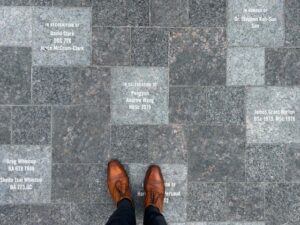
Here’s a charity trade secret. One of the best products in a fundraiser’s toolkit is “donor recognition”, in particular naming a piece of real estate. Recognition is effective in inspiring donors, and for some, but not all, an important part of charitable giving. However, donor recognition sometimes produces a backlash from the public. Yes, donor recognition is gracious and pragmatic, but public space is branded by private citizens and money. How do we balance these views to achieve positive social outcomes?
The Landmark Project
Recently, I attended the donor recognition event at the University of Toronto for The Landmark Project, an impressive reconstruction of the central St. George Campus. My wife and I are donors, and yes, there is some naming involved. There is a bench in honour of our parents – mine who met at UofT and Barbara’s who never had the opportunity to attend any university. The Project is part landscaping, part pedestrian renaissance, and part environmental overhaul. The result is an inviting, beautiful public space in increasingly crowded downtown Toronto. The event got me thinking about donor recognition – as well as environmental transformation and community place making.
Environmental Transformation
Remarkably, the core of the project is greenhouse gas mitigation – and carbon tax reduction. King’s College Circle, the heart of the campus, was excavated for a massive geothermal field. The largest field in Canada, the front campus field has 250m deep rods sunk into limestone that will heat and cool the campus. Along the way it will save 15,000 metric tons of greenhouse gases per annum, the equivalent of 3,000 cars. On top of the field, is an underground parking lot, which removes 500 surface parking spots. On top of the parking lot is a public common, a landscaped green space.
One of the pioneers of geoexchange is University of Toronto’s own Prof. Frank Hooper. He led the installation of Canada’s first residential ground-source heat pump system in the 1940s. Dr. Hooper showed that the stable underground temperatures could be tapped to heat and cool buildings. His ideas inform this project. The University wants to be a net green energy producer by 2050. This geothermal project makes it possible – and anybody can view the working plant next to the parking garage.
Community Place Making
The project is on private university land, but the thinking that informs it is public space. As a student, I dodged cars on the flat circle. It was a place of transition and hustle. There were no places to sit, read, meet, eat. The new landscape has 22 new gardens, new trees, and it undulates. No longer flat, it has visually separated spaces with tables, chairs, and benches. There is an outdoor classroom and an indigenous garden, dog walkers, and not a car in sight. When I was there were two community yoga groups, a pickup soccer game, and a disorganized, but enthusiastic Quidditch game. It was filled with people. The campus is now a public park – the most beautiful in the city.
Donor Recognition or Acknowledgement
A big, privately funded landscaping project provides a lot of opportunities for donor recognition. Architectural features, gardens, benches, and granite pavers – thousands of granite pavers. What I found unexpectedly moving about the campaign was who donated. There were over 4000 donors, from 32 countries, and 3,500 granite bricks, all with names attached. This is the wiki element of recognition. Donors remember family members, inscribed messages about the importance of education, and the value of education. Gratitude is everywhere. People from around the world are not just donating but making their connection to the university tangible, visible.
This kind of recognition is in the category of acknowledgement. There is mutual acknowledge by both donors and university of why the place and the education it provides is important. Acknowledgement is built into the landscape and becomes part of the place. There are thousands of stories, and they sing in harmony. There is no one voice, or big donor, dominating. Over time the inscriptions will fade, but, for right now, it is a moving example of the university community coming together to create a new space is an old setting. For the university and for its neighbours and the public.
Estate Donations
Since this article is being published in an estates blog, it should be noted that, traditionally, most estate donations in Canada are unrestricted and rarely recognized in a prominent fashion. A will names a charity. A donation may contain broad restrictions, but rarely involves naming. This may be changing as the value of estate donations increases. Charitable bequests are the original form of “trust-based philanthropy” – an intergenerational transfer of wealth and an expression of trust in an organization. It’s a quiet form of legacy, which makes it more important to remember the human connection to the cause.

0 Comments